In harmony with the new City | Read more at in70mm.com The 70mm Newsletter |
| Written by: Architect: LEONARD ALLEN, FIAA | Date: 01.03.2011 |
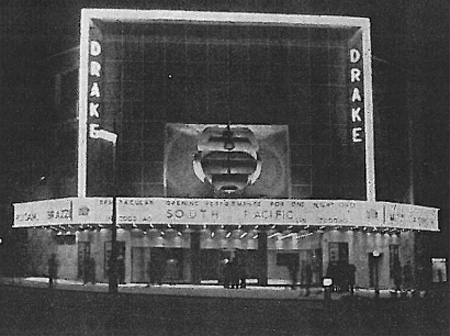 Exterior of the Drake at
night, showing the very attractive lighting of the Golden Hind sign Exterior of the Drake at
night, showing the very attractive lighting of the Golden Hind signPLYMOUTH'S new cinema, the Drake, erected for Twentieth Century-Fox, occupies a prominent position in the rebuilt City centre at the corner of Union Street and Derry's Cross. Chosen to harmonise with the surrounding buildings, Portland Stone has been employed for facing the facades to the two street frontages. The entrance is placed at the intersection of the two frontages, and has been splayed off to form a bold corner entrance surmounted by a deep canopy with a total length of 100 feet and a fascia depth of five feet arranged as an interchangeable letter sign for publicity display. Above the canopy this elevation is faced in Mineralite in a pleasing blue shade divided into a bold squared design with white bands of the same material. This is surrounded by a Portland Stone frame, the vertical members of which carry the theatre name signs. In the centre a deep recess contains a realistic half-scale model of Drake's Golden Hind conforming in all details with authentic information available of this famous ship. | More in 70mm reading: The Drake, Plymouth, England The Versatile Projectors, Screen and Sound The Technical Side. We Aimed at Perfection Demonstration of Our Faith in the Future The Saga of Todd-AO DP70 / Universal 70-35 / Norelco AAII - The Todd-AO Projector Internet link: |
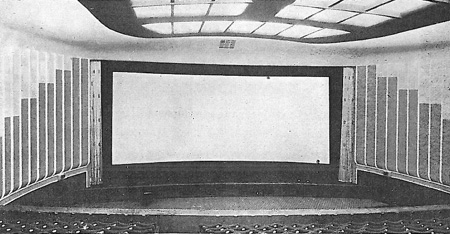 The screen at the Drake is one of the largest ever
installed in this country. It is unusual in that the curvature can be
varied to a wide degree The screen at the Drake is one of the largest ever
installed in this country. It is unusual in that the curvature can be
varied to a wide degreeEnamelled plaques and brightly coloured balustrades give further colour relief to the stone-faced elevations. The remaining elevations are faced in two shades of local facing bricks relieved at intervals with a small pattern design of projecting bricks. A spacious open vestibule is floored in random marble paving and decorated with lilac-coloured glass mosaic to the walls. It contains the box-office, and a small confectionery kiosk leads to a double-screen of armour-plate glass entrance doors leading to the main foyer. | |
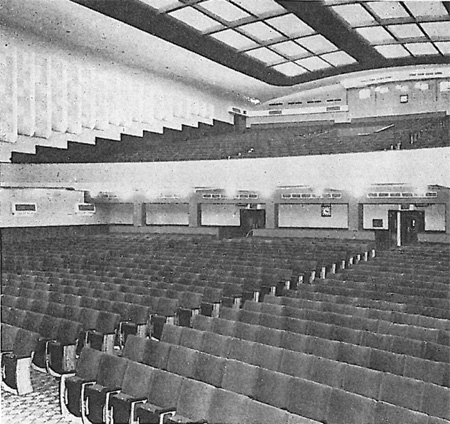 The auditorium, showing the adequate space
between rows The auditorium, showing the adequate space
between rowsThis is panelled with Sapele mahogany and decorated with a dark blue ceiling divided into panels with white bands with a frieze in yellow and lilac. The floor is finished in linoleum tiles in shades of yellow and grey. This main foyer accommodates on the left the wide staircase leading to the circle. The stalls foyer and entrances are placed on the right. The centre of the space is devoted to an attractive and spacious sales counter canopied with a brightly illuminated decorative grille. The four columns standing at the corner of this counter are painted in brilliant red. The carpeted staircase is provided with a balustrade composed of vitreous enamelled panels in alternating shades of grey and yellow and capped with a black, plastic handrail. | |
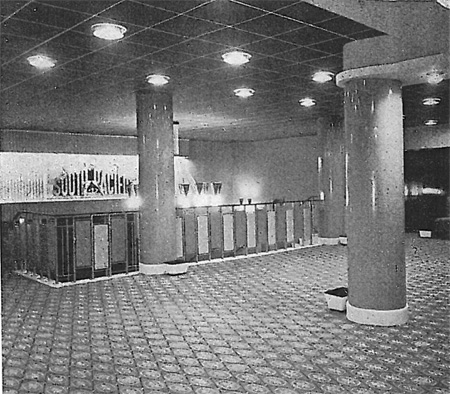 The spacious circle foyer. The spacious circle foyer.This staircase divides to left and right and leads to the circle foyer, which is decorated in a similar manner to the main foyer with mahogany panelled walls, painted ceilings and frieze, and is carpeted with a specially designed carpet embodying the 20th Century-Fox motif. The entrance doors to the circle are flanked with floral display fittings. A public telephone kiosk is provided in a secluded recess. The auditorium is decorated in tones of red, pink and pale blue. The main ceiling surface is painted ocean blue and is brilliantly illuminated by large, suspended, plaster lighting troughs, the undersides of which are painted in deep regal red. The upper walls are lined with acoustic tiles fixed between vertical fibrous plaster ribs and arranged at an angle to the main wall in a saw-tooth formation. | |
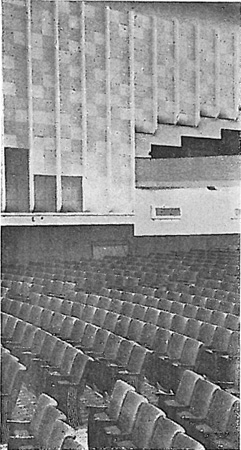 Close-up of the
specially designed panelling on the side-walls Close-up of the
specially designed panelling on the side-wallsA pile carpet wall lining to match the seat coverings has been employed in place of the more usual wood panelling to form a dado to the side gangways at stalls level. The gangways and seatways are covered in a similar carpet to the circle foyer. The ante-proscenium walls are decorated in Siamese pink and the remainder in tones of blue rose and briar pink. Special attention has been given in designing the theatre to arrange the inclination of the stalls floors and the steppings in the circle to provide perfect sight lines to the screen from the patrons' seats and secure a minimum angle of projection to avoid distortion. The conventional proscenium has been eliminated and the side walls of the auditorium sweep in a bold curve to merge into the screen upon which a picture 60 feet in width can be shown. | |
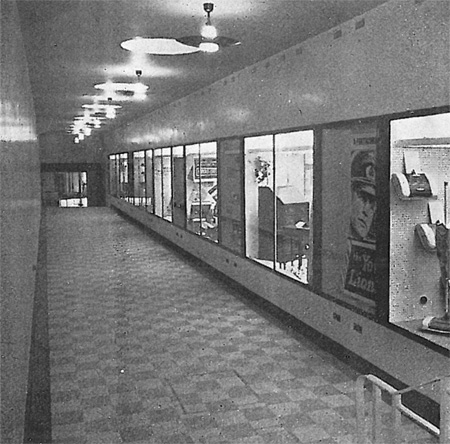 The covered queueing area The covered queueing areaThe plenum ventilating equipment is of a high standard and is able to deliver filtered conditioned air in ample quantities to all parts of the theatre. The projection room is of generous proportions and contains the most up-to-date form of projection and sound equipment. A special amenity feature is the commodious waiting hall provided for patrons awaiting admission. This is comfortably furnished and decorated, well-lighted, heated and ventilated. It contains a separate sales kiosk for the use of waiting patrons and has direct access from the street to the auditorium. A number of attractive showcases have been introduced as a decorative feature and for the display of interesting items. It is expected that these will be used by local trades people. | |
 The circle, showing the shallow rake. The circle, showing the shallow rake.Attractively designed cloakrooms and powder rooms and adequate toilet accommodation are provided to both the stalls and circle levels. A large public car park is available for those arriving by car and a special entrance has been provided therefrom to avoid patrons having to walk more than a few yards from the park. External illumination is provided by means of white fluorescent tubing to the name signs and the outline of the splayed corner. Floodlights provide brilliant illumination to the Golden Hind motif. The canopy is internally illuminated in yellow cold cathode tubes and the underside extending as far as the armour-plate glass doors is furnished with 150 watt mirrored back lamps at three feet centres. | |
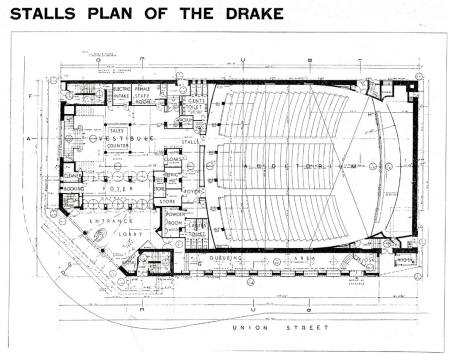 Click
image to see enlargement Click
image to see enlargement |
|
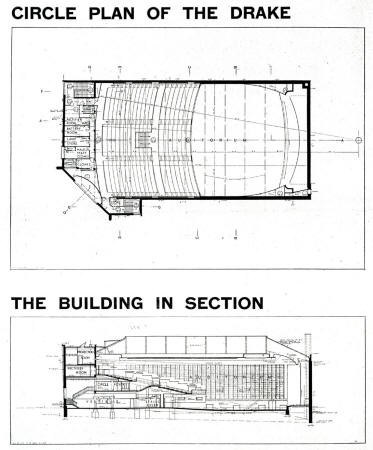 Click
image to see enlargement Click
image to see enlargement | |
| Go: back - top - back issues - news index Updated 22-01-25 |
